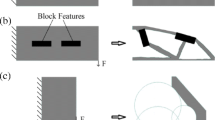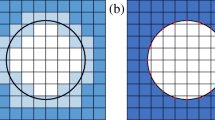Abstract
Automatic meshing algorithms for finite element analysis are based on a computer understanding of the geometry of the part to be discretized. Current mesh generators understand the part as either a boundary representation, an octree, or a point set. A higher-level understanding of the part can be achieved by associating engineering significance and engineering data, such as loading and boundary conditions, with generic shapes in the part. This technique, called feature-based modeling, is a popular approach to integrating computer-aided design (CAD) and computer-aided manufacturing through the use of machinable shapes in the CAD model. It would seem that feature-based design also could aid in the finite element mesh generation process by making engineering information explicit in the model.
This paper describes an approach to feature-based mesh generation. The feature representation of a fully functioning feature-based system that does automatic process planning and inspection was extended to include finite element mesh generation. This approach is based on a single feature representation that can be used for design, finite element analysis, process planning, and inspection of prismatic parts. The paper describes several advantages that features provide to the meshing process, such as improved point sets and a convenient method of simplifying the geometry of the model. Also discussed are possible extensions to features to enhance the finite element meshing process.
Similar content being viewed by others
References
Shah, J.J.; Bhatnagar, A.; Hsiao, D. (1988) Feature mapping and application shell. In: Proceedings of the 1988 ASME Computers in Engineering Conference, San Francisco, CA, pp. 489–496, July 31–August 4
External representation of product definition data (1989) ISO Draft Proposal 10303, ISO TC184/SC4 N38. Gaithersburg, MD, NIST
Turner, G.P.; Anderson, D.C. (1988) An object-oriented approach to interactive, feature-based design for quick turnaround manufacturing. In: Proceedings of the 1988 ASME Computers in Engineering Conference, San Francisco, CA, pp. 551–556, July 31–August 4
Henderson, M.R. (1984) Extraction of feature information from three dimensional CAD data. PhD thesis, Purdue University. West Lafayette, IN, May
Ames, A.L. (1988) Automated generation of uniform group technology part codes from solid model data. In: Proceedings of the 1988 ASME Computers in Engineering Conference, San Francisco, CA, pp. 433–437, July 31–August 4
Dixon, J.R.; Libardi Jr. E.C.; Luby, S.C.; Vaghul, M.; Simmons, M.K. (1987) Expert systems for mechanical design: Examples of symbolic representations of design geometries. Eng. Comput. 2, 1–10
Graves, G.R.; Sahay, A.; Parks, C.M. (1989) A functional approach to feature recognition in production planning. Int. J. Comput. Integr. Manuf. (UK), 2, 162–171
Dixon, J.R.; Cunningham, J.J.; Simmons, M.K. (1987) Research in designing with features. In: IFIP WG 5.2 Workshop on Intelligent CAD, Cambridge, MA, October 6–7
Hummel, K.E.; Brooks, S.L. (1986) Symbolic representation of manufacturing features for an automated process planning system. In: Knowledge-Based Expert Systems for Manufacturing, ASME Winter Annual Meeting, Anaheim, CA, pp. 233–244, December 7–12
Cutkosky, M.R.; Tenenbaum, J.M.; Muller, D. (1988) Features in process-based design. In: Proceedings of the 1988 ASME Computers in Engineering Conference, San Francisco, CA, pp. 557–562, July 31–August 4
Woodwark, J. (Ed.) (1989) Geometric Reasoning. New York: Oxford University Press
Libardi Jr., E.C.; Dixon, J.R.; Simmons, M.K. (1988) Computer environments for the design of mechanical assemblies: A research review. Eng. Comput. 3, 121–136
Pinilla, J.M.; Finger, S.; Prinz, F.B. (1989) Shape feature description and recognition using an augmented topology graph grammar. In: NSF Engineering Design Research Conference, University of Massachusetts, Amherst, pp. 285–300, June 11–14
Shah, J.J.; Wilson, P.R. (1988) Analysis of knowledge abstraction, representation and interaction requirements for computer aided engineering. In: Proceedings of the 1988 ASME Computers in Engineering Conference, San Francisco, CA, pp. 17–24, July 31–August 4
Shephard, M.S. (1988) The role of features in the generation and control of numerical analysis models. In: UCLA/NSF Workshop on Features in Design and Manufacturing, UCLA, February 26–28
Chang, T.C. (1987) Integrated process planning approach for discrete part machining. In: 14th Conference on Production Research and Technology, University of Michigan, Ann Arbor, MI, pp. 43–50, October 6–9
Henderson, M.R. (1986) Automated group technology part coding from a three-dimensional CAD database. In: Symposium on Knowledge-Based Expert Systems for Manufacturing, ASME Winter Annual Meeting, Anaheim, CA, pp. 195–204, December 7–12
Cunningham, J.J.; Dixon, J.R. (1988) Designing with features: The origin of features. In: Proceedings of the 1988 ASME Computers in Engineering Conference, San Francisco, CA, pp. 237–243, July 31–August 4
Anderson, D.C.; Chang, T.C. (1989) Automated process planning using object-oriented feature based design. In: Proceedings of the International Symposium on Advanced Geometric Modelling for Engineering Applications, Berlin, West Germany, pp. 233–246, November 8–10
Chang, T.C.; Anderson, D.C.; Mitchell, O.R. (1988) QTC—An integrated design/manufacturing/vision inspection system for prismatic parts. In: Proceedings of the 1988 ASME International Computers in Engineering Conference, San Francisco, CA, pp. 417–426, July 31–August 4
Anderson, D.C.; Chang, T.C. (1990) Geometric reasoning in feature based design and process planning. Comput. Graph. 14, 221–235
Mashburn, T. (1987) A polygonal solid modeling package. MS thesis, Purdue University, West Lafayette, IN, December
Jain, A. (1986) Modern methods for automatic FE mesh generation. In: Modern Methods for Automating Finite Element Mesh Generation, (Ed. K. Baldwin), American Society of Civil Engineers, New York, pp. 19–28, October 31
Wördenweber, B. (1981) Automatic mesh generation of 2 and 3 dimension curvilinear manifolds. PhD thesis, St. John's College, University of Cambridge, England, November
Yerry, M.A.; Shephard, M.S. (1984) Automatic three-dimensional mesh generation by the modified-octree technique. Int. J. Numer. Meth. Eng. 20, 1965–1990
Perucchio, R.; Saxena, M.; Kela, A. (1989) Automatic mesh generation from solid models based on recursive spatial decompositions. Int. J. Numer. Meth. Eng. 28, 2469–2501
Cavendish, J.C.; Field, D.A.; Frey, W.H. (1985) An approach to automatic three-dimensional finite element mesh generation. Int. J. Numer. Meth. Eng. 21, 329–347
Schroeder, W.J.; Shephard, M.S. (1989) An O(n) algorithm to automatically generate geometric triangulations satisfying the Delaunay circumsphere criteria. Eng. Comput. 5, 177–193
Watson, D.F. (1981) Computing the N-dimensional Delaunay tesselation with applications to Voronoi Polytopes. Comput. J. 24, 167–172
Baker, T.J. (1989) Automatic mesh generation for complex three-dimensional regions using a constrained Delaunay triangulation. Eng. Comput. 5, 161–175
Shephard, M.S.; Finnigan, P.M. (1988) Integration of geometric modeling and advanced finite element preprocessing. Finite Elem. Anal. Des. 4, 147–162
Shephard, M.S. (1990) Idealization in engineering modeling and design. Res. Eng. Des. 1, 229–238
Gregory, B.L.; Shephard, M.S. (1987) The generation of airframe finite element models using an expert system. Eng. Comput. 2, 65–77
Finnigan, P.M.; Kela, A.; Davis, J.E. (1989) Geometry as a basis for finite element automation. Eng. Comput. 5, 147–160
Shephard, M.S. (1986) Geometric modeling needs of finite element modeling. In: Geometric modeling for CAD applications. (Eds. M.J. Wozny; H.W. McLaughlin; J.L. Encarnacao) Elsevier Science Pub. Co. Rensselaerville, NY; pp. 271–293, May 12–16
Author information
Authors and Affiliations
Rights and permissions
About this article
Cite this article
Unruh, V., Anderson, D.C. Feature-based modeling for automatic mesh generation. Engineering with Computers 8, 1–12 (1992). https://doi.org/10.1007/BF01206333
Issue Date:
DOI: https://doi.org/10.1007/BF01206333




